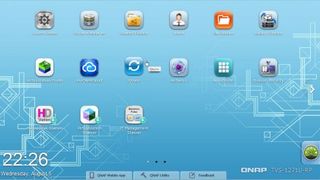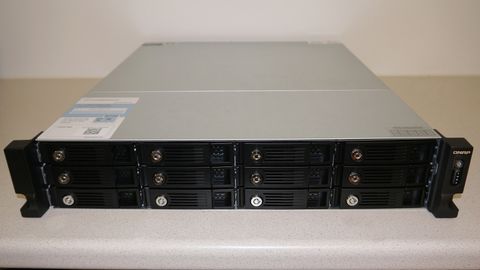Why you can trust TechRadar
Of course what's on the inside also matters, with access to the internals of the TVS-1271U-RP provided via a slide-off hatch on the top of the unit. Underneath is a compact motherboard with a single processor socket which, depending on what you want to achieve and how much you can afford, can be an Intel Pentium, Core i3, Core i5 or, as with our review appliance, a Core i7 processor.

In fact the processor in the appliance we tested turned out to be a quad-core, eight thread i7-4709S clocked at 3.2GHz. With built in Intel HD graphics, this isn't quite what you'd expect in a server, but it delivers more than enough motive power for a NAS appliance and with an HDMI port at the back also enables the TVS-1271U-RP to be used as a desktop computer using a package of software options known as QvPC (QNAP virtual PC). This means that, to take an example, this device can act as the main surveillance monitor on a CCTV system or provide limited VDI capabilities.
Selling for £2,118 ex VAT (around $3,300, or AU$4,500) without any disks, the price includes a full 32GB of DDR3 memory filling all four available DIMM slots. The QNAP firmware, called QTS, is also included with no further licensing required for most of the built-in and optional applications including file sharing across multiple platforms with support for Windows, Apple Mac and Linux networks.
Putting it to work
Cloud-based setup is the order of the day using a special Cloud Key printed on a label on the top of the chassis, followed by day-to-day management from a browser which employs a Synology and Windows-like desktop interface.
Using this we were able to create users and configure our storage with all the expected JBOD, RAID and hot sparing options plus the ability to create storage pools for easy management with thin provisioning and the ability to create multiple NAS and iSCSI shares for simultaneous use.
This we found very easy to get to grips with, and for testing we opted for a basic RAID 5 array across four of our WD Red drives. We then used the ATTO benchmark to measure throughput, the QNAP software easily saturating the available Gigabit port bandwidth with data when pushed hard by multiple clients.

File sharing, however, is far from the only trick up the sleeve of the Linux-based QTS software with a host of backup tools included to, for example, put the appliance to use as a large capacity backup store on a small business network. Moreover, a number of optional apps are also available to run on the appliance, some from QNAP while others are either open source or from third-party developers.
These are all easily downloaded and installed with the one we liked the most being a unique application called Virtualization Station that lets you run VMs on the QNAP appliance. This can be further teamed up with the QvPC technology to enable users to run Windows, Linux and even Android applications remotely on the QNAP platform.

Beyond this there are database, content management and even ERP tools – plus lots of media and entertainment apps, which could be confusing as we really don't see the TVS-1271U-RP as a consumer buy.

My haunted Roomba S9+ kept me up all night and iRobot says there’s no way to fix it

HP launched a very promising ultra portable XPS13 killer laptop — the 1kg EliteBook 635 Aero G11 is only available in Japan with seemingly no plans for a global launch, but why?

Is this the best time ever for iPhone deals at Verizon? Multiple devices are free without the need for an annoying trade
